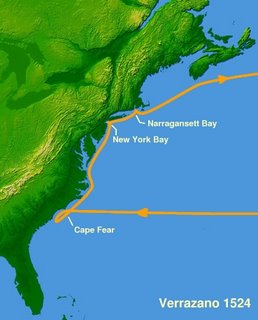
For the previous entry in this series, click here.
Formal European exploration of North America entered a dormant period in the 1510s, apart from Juan Ponce de Leon's reconnaissance of Florida. No Indians crossed the Atlantic during this decade.
In 1521, Spanish official Lucas Vasquez de Ayllon sent an expedition to the Florida coast to determine whether the mainland Indians would make suitable slaves for the West Indies sugar plantations. The expeditionaries captured 70 men and women and carried them back to Santo Domingo. By the time they arrived, however, Ayllon had gotten cold feet about enslaving Indians: King Charles I had begun enforcing the 1512 Laws of Burgos, which prohibited Indian slave-catching. Ayllon thus ordered the captives set free.
Many of the freed slaves died of starvation, but one, a Christian convert named Francisco de Chicora, accompanied Ayllon to Spain in 1522-23 to represent his homeland (the so-called province of "Chicora"). While Francisco had learned Spanish, Ayllon apparently used him as a prop while he spread stories about Chicora and petitioned the Crown for a patent of colonization, which the king granted in 1523. Ayllon subsequently led 500 Spanish colonists and African slaves to the coast of present-day South Carolina, where in 1526 he established the short-lived colony of San Miguel de Gualdape (and died shortly thereafter). Francisco's fate is uncertain, but he may have accompanied Ayllon to San Miguel as a translator. (David Quinn, North America from Earliest Discovery to First Settlements, 143-146.)
Meanwhile, King Francis I of France and the Queen Mother, Louise of Savoy, commissioned a company of merchants to explore the Atlantic coast of North America and search for an all-water passage to the Pacific. The company appointed the Florentine navigator Giovanni de Verrazzano to undertake the mission, and after a few false starts Verrazzano set out in his caravel La Dauphine. From March to June 1524 Verrazzano charted the North American coast from Cape Fear to Cape Breton Island, stopping periodically to take on water and provisions and to describe the Indian peoples he encountered. The more southerly nations seemed relatively trusting and were willing to trade maize and venison for inexpensive trinkets, while those living to the north were more suspicious and would only accept useful merchandise (particularly metal blades) in trade. The northeasterners had apparently been trading with fishermen for several decades and had discovered a need for caution in dealing with Europeans. During one of his landings on the coast, in present-day Virginia, Verrazzano took an Indian (Algonquin) boy captive, presumably to present to the King and possibly to train as an interpreter. Whether or not Verrrazzano's captive actually survived the voyage is a matter for speculation, though the return voyage was quick and took place in late spring, so the probability of survival was higher for this Indian traveler than it would have been for Columbus's Indian slaves. (Quinn, op. cit., 153-158; Neal Salisbury, Manitou and Providence, 52-53.)
For the next entry in this series, click here.
No comments:
Post a Comment